Cooperative Game-Based Energy Efficiency Management over Ultra-Dense Wireless Cellular Networks
Abstract
:1. Introduction
- We formulate the power-coordination problem in macro cells and small cells as a cooperative Nash bargaining game to improve the comprehensive EE, where the inter-tier and intra-tier interference limitations are imposed to provide reliable transmission for the network users, and the maximum power is considered to guarantee the fairness for the base stations in each cell.
- We define a unified energy-efficient utility function for the optimization problem in ultradense wireless cellular networks, where the near optimal cooperative bargaining power-coordination strategy is derived by introducing time-sharing variables and the Lagrangian function. Accordingly, the closed-form power-coordination solutions with consideration of both interference mitigation and energy saving are derived, which show the convergence of a Pareto-optimal equilibrium for the cooperative game.
- A simplified algorithm is proposed to combat the complicate signaling overhead, which is a challenge in the scenario of the ultradense deployment of small cells, and yields a suboptimal power-coordination solution.
- The proposed algorithm is evaluated by numerical simulations, which illustrates the convergence property and the efficiency of our power-coordination scheme, allowing a good tradeoff between three different energy-efficiency metrics.
2. System Model and Network Energy-Efficiency Model
2.1. System Model
2.2. Network Energy-Efficiency Model
3. Cooperative Game in Ultra-Dense Wireless Cellular Networks
3.1. Definitions and Concepts of Cooperative Game
- (1)
- Individual rationality: for .
- (2)
- Feasibility:.
- (3)
- Pareto-optimality: U* is Pareto-optimal.
- (4)
- Independence of irrelevant alternatives: if and , then .
- (5)
- Independence of linear transformations: For any linear scale transformation
- (6)
- Symmetry: if Γ is invariant under all exchanges of players (base stations), .
3.2. Utility Design and Bargaining Cooperative Game Formulation
4. Bargaining Problem Solutions for Ultradense Wireless Cellular Networks
4.1. Problem Simplification
4.2. Solution of Cooperative Bargaining Game
- (1)
- When αm is large, MeNBm focuses more on the EE (e.g., αm > 1/3); thus, less transmission power is needed for MeNBm.
- (2)
- When βm is large, MeNBm focuses more on the DE (e.g., βm > 1/3); thus, less transmission power is needed for MeNBm.
- (3)
- When N and J are large, that is, many SeNBs with many SUEs are deployed in the macro-cell controlled by MeNBm, if these SeNBs are deployed near MeNBm, as a result, MeNBm provides a lower transmission power. In this sense, the strategy takes full account of the benefits to the opponents.
- (4)
- When hn is large, the aggregate CINRs of all SUEs are good enough; thus, MeNBm can provide a large transmission power to enhance its capacity.
- (1)
- When αn is large, SeNBn focuses more on the EE (e.g., αn > 1/3); thus, less transmission power is needed for SeNBn.
- (2)
- When βn is large, SeNBn focuses more on the DE (e.g., βn > 1/3); thus, less transmission power is needed for SeNBn.
- (3)
- When M and I are large, that is, many MeNBs with many MUEs are deployed in the microcell controlled by SeNBn, if these MeNBs are deployed near SeNBn, SeNBn provides a lower transmission power. In this sense, the strategy takes full account of the benefits to the opponents.
- (4)
- When hm is large, the aggregate CINRs of all MUEs are good enough; thus, SeNBn can provide a large transmission power to enhance its capacity.
4.3. Cooperative-Bargaining Power-Scheduling Algorithm
| Algorithm 1: Cooperative-Bargaining Power-Scheduling Algorithm |
| 1: Initialization: MeNBm and SeNBn, m∈M, n∈N, choose power levels pm(0) and pn(0); predefine the coefficients αm, βm, αn, and βn; predefine the Lagrangian parameters and at step t. |
| 2: for each SUE of each SeNBn do |
| 3: gather the CINR: |
| 4: end for |
| 5: So |
| 6: while not for any small do |
| 7: adjust MeNBm ‘s power at the next step (t + 1) by: |
| 8: update by MeNBm as: |
| 9: end while |
| 10: for each MUE of each MeNBm do |
| 11: gather the CINR: |
| 12: end for |
| 13: So |
| 14: while not for any small do |
| 15: adjust SeNBn ‘s power at the next step (t + 1) by: |
| 16: update by SeNBn as: |
| 17: end while |
4.4. Simplified Algorithm for Sub-Optimal Solution
5. Simulation Results and Discussion
6. Conclusions
Acknowledgments
Author Contributions
Conflicts of Interest
References
- Bhushan, N.; Li, J.; Malladi, D.; Gilmore, R.; Brenner, D.; Damnjanovic, A.; Sukhavasi, R.; Patel, C.; Geirhofer, S. Network Densification: The Dominant Theme for Wireless Evolution in 5G. IEEE Commun. Mag. 2014, 52, 82–89. [Google Scholar] [CrossRef]
- Hwang, I.; Song, B.; Soliman, S.S. A holistic view on hyper-dense heterogeneous and small cell networks. IEEE Commun. Mag. 2013, 51, 20–27. [Google Scholar] [CrossRef]
- Hoydis, J.; Ten Brink, S.; Debbah, M. Massive MIMO in the UL/DL of Cellular Networks: How Many Antennas Do We Need? IEEE J. Sel. Areas Commun. 2013, 31, 160–171. [Google Scholar] [CrossRef] [Green Version]
- Rappaport, T.S.; Shu, S.; Mayzus, R.; Zhao, H.; Azar, Y.; Wang, K.; Wong, G.N.; Schulz, J.K.; Samimi, M.; Gutierrez, F. Millimeter Wave Mobile Communications for 5G Cellular: It Will Work! IEEE Access 2013, 1, 335–349. [Google Scholar] [CrossRef]
- Wang, C.X.; Haider, F.; Gao, X.; You, X.H.; Yang, Y.; Yuan, D.F.; Aggoune, H.M.; Haas, H.; Fletcher, S.; Hepsaydir, E. Cellular Architecture and Key Technologies for 5G Wireless Communication Networks. IEEE Commun. Mag. 2014, 52, 122–130. [Google Scholar] [CrossRef]
- Ge, X.; Tu, S.; Mao, G.; Wang, C.X. 5G ultra-dense cellular networks. IEEE Trans. Wirel. Commun. 2015, 23, 72–79. [Google Scholar] [CrossRef]
- Asadi, A.; Sciancalepore, V.; Mancuso, V. On the efficient utilization of radio resources in extremely dense wireless networks. IEEE Commun. Mag. 2015, 53, 126–132. [Google Scholar] [CrossRef]
- Soret, B.; Pedersen, K.I.; Jorgensen, N.T.K.; Fernandez-Lopez, V. Interference coordination for dense wireless networks. IEEE Commun. Mag. 2015, 53, 102–109. [Google Scholar] [CrossRef]
- Yunas, S.F.; Valkama, M.; Niemelä, J. Spectral and energy efficiency of ultra-dense networks under different deployment strategies. IEEE Commun. Mag. 2015, 53, 90–100. [Google Scholar] [CrossRef]
- Feng, D.; Jiang, C.; Lim, G.; Cimini, L.J.; Feng, G.; Li, G.Y. A survey of energy-efficient wireless communications. IEEE Commun. Surv. Tutor. 2013, 15, 167–178. [Google Scholar] [CrossRef]
- Shakir, M.Z.; Qaraqe, K.A.; Tabassum, H.; Alouini, M.S.; Serpedin, E.; Imran, M.A. Green heterogeneous small-cell networks: Toward reducing the CO2 emissions of mobile communications industry using uplink power adaptation. IEEE Commun. Mag. 2013, 51, 52–61. [Google Scholar] [CrossRef]
- Orsino, A.; Araniti, G.; Militano, L.; Alonso-Zarate, J.; Molinaro, A.; Iera, A. Energy efficient iot data collection in smart cities exploiting D2D communications. Sensors 2016, 16, 836. [Google Scholar] [CrossRef] [PubMed]
- Gharehshiran, O.N.; Attar, A.; Krishnamurthy, V. Collaborative sub-channel allocation in cognitive LTE Femto-cells: A cooperative game-theoretic approach. IEEE Trans. Commun. 2013, 61, 325–334. [Google Scholar] [CrossRef]
- Bennis, M.; Simsek, M.; Czylwik, A.; Saad, W.; Valentin, S.; Debbah, M. When cellular meets wifi in wireless small cell networks. IEEE Commun. Mag. 2013, 51, 44–50. [Google Scholar] [CrossRef] [Green Version]
- Johansson, K. Cost Effective Deployment Strategies for Heterogenous Wireless Networks. Ph.D. Thesis, KTH Information and Communication Technology, Stockholm, Sweden, 2007. [Google Scholar]
- Yang, C.; Li, J.; Anpalagan, A. Energy efficiency architecture design for heterogeneous cellular networks. Wirel. Commun. Mob. Com. 2015. [Google Scholar] [CrossRef]
- Ghosh, A.; Mangalvedhe, N.; Ratasuk, R.; Mondal, B. Heterogeneous cellular networks: From theory to practice. IEEE Commun. Mag. 2012, 50, 54–64. [Google Scholar] [CrossRef]
- Zhang, H.; Chu, X.; Guo, W.; Wang, S. Coexistence of Wi-Fi and heterogeneous small cell networks sharing unlicensed spectrum. IEEE Commun. Mag. 2014, 53, 158–164. [Google Scholar] [CrossRef]
- Saquib, N.; Hossain, E.; Le, L.B.; Kim, D.I. Interference management in OFDMA femtocell networks: Issues and approaches. IEEE Wirel. Commun. 2012, 19, 86–95. [Google Scholar] [CrossRef]
- Ngo, D.T.; Long, B.L.; Lengoc, T.; Hossain, E.; Dong, I.K. Distributed interference management in two-tier cdma femtocell networks. IEEE Trans. Wirel. Commun. 2012, 11, 979–989. [Google Scholar] [CrossRef]
- Shen, S.; Lok, T.M. Dynamic power allocation for downlink interference management in a two-tier ofdma network. IEEE Trans. Veh. Technol. 2013, 62, 4120–4125. [Google Scholar] [CrossRef]
- Guruacharya, S.; Niyato, D.; Dong, I.K.; Hossain, E. Hierarchical competition for downlink power allocation in ofdma femtocell networks. IEEE Trans. Wirel. Commun. 2013, 12, 1543–1553. [Google Scholar] [CrossRef]
- Chandrasekhar, V.; Andrews, J.G.; Muharemovic, T.; Shen, Z.; Gatherer, A. Power control in two-tier femtocell networks. IEEE Trans. Wirel. Commun. 2009, 8, 4316–4328. [Google Scholar] [CrossRef]
- Xie, R.; Yu, F.R.; Ji, H.; Li, Y. Energy-efficient resource allocation for heterogeneous cognitive radio networks with femtocells. IEEE Trans. Wirel. Commun. 2012, 11, 3910–3920. [Google Scholar]
- Yun, J.H.; Shin, K.G. Adaptive interference management of ofdma femtocells for co-channel deployment. IEEE J. Sel. Areas Commun. 2011, 29, 1225–1241. [Google Scholar] [CrossRef]
- Han, Z.; Niyato, D.; Saad, W.; Basar, T.; Hjorungnes, A. Game Theory in Wireless and Communication Networks: Theory, Models, and Applications; Cambridge University Press: Cambridge, UK, 2012; pp. 171–220. [Google Scholar]
- Su, T.; Zheng, W.; Li, W.; Ling, D.; Wen, X. Energy-efficient power optimization with Pareto improvement in two-tier femtocell networks. In Proceedings of IEEE International Symposium on Personal Indoor & Mobile Radio Communications, Sydney, Australia, 9–12 September 2012; pp. 2512–2517.
- Han, Z.; Ji, Z.; Liu, K.J.R. Non-cooperative resource competition game by virtual referee in multi-cell ofdma networks. IEEE J. Sel. Areas Commun. 2007, 25, 1079–1090. [Google Scholar] [CrossRef]
- Zhang, H.; Chu, X.; Ma, W.; Zheng, W.; Wen, X. Resource allocation with interference mitigation in OFDMA femtocells for co-channel deploymenta. EURASIP J. Wirel. Commun. Netw. 2012, 12, 1–9. [Google Scholar] [CrossRef]
- Haykin, S. Cognitive radio: Brain-empowered wireless communications. IEEE J. Sel. Areas Commun. 2006, 23, 201–220. [Google Scholar] [CrossRef]
- Yang, C.; Li, J.; Anpalagan, A.; Guizani, M. Joint power coordination for spectral-and-energy efficiency in heterogeneous small cell networks: A bargaining game-theoretic perspective. IEEE Trans. Wirel. Commun. 2015, 15, 1364–1376. [Google Scholar] [CrossRef]
- Zhang, H.; Jiang, C.; Beaulieu, N.C.; Chu, X.; Wang, X.; Quek, T.Q.S. Resource allocation for cognitive small cell networks: A cooperative bargaining game theoretic approach. IEEE Trans. Wirel. Commun. 2015, 14, 3481–3493. [Google Scholar] [CrossRef]
- Yang, C.; Li, J.; Anpalagan, A. Cooperative bargaining game-theoretic methodology for 5g wireless heterogeneous networks. Trans. Emerg. Telecommun. Technol. 2015, 26, 70–81. [Google Scholar] [CrossRef]
- Long, B.L.; Niyato, D.; Hossain, E.; Dong, I.K.; Hoang, D.T. Qos-aware and energy-efficient resource management in ofdma femtocells. IEEE Trans. Wirel. Commun. 2013, 12, 180–194. [Google Scholar]
- Xiong, C.; Li, G.Y.; Zhang, S.; Chen, Y. Energy-and spectral-efficiency tradeoff in downlink ofdma networks. IEEE Trans. Wirel. Commun. 2011, 10, 1–5. [Google Scholar] [CrossRef]
- Ngo, D.T.; Long, B.L.; Le-Ngoc, T. Distributed pareto-optimal power control for utility maximization in femtocell networks. IEEE Trans. Wirel. Commun. 2012, 11, 3434–3446. [Google Scholar] [CrossRef]
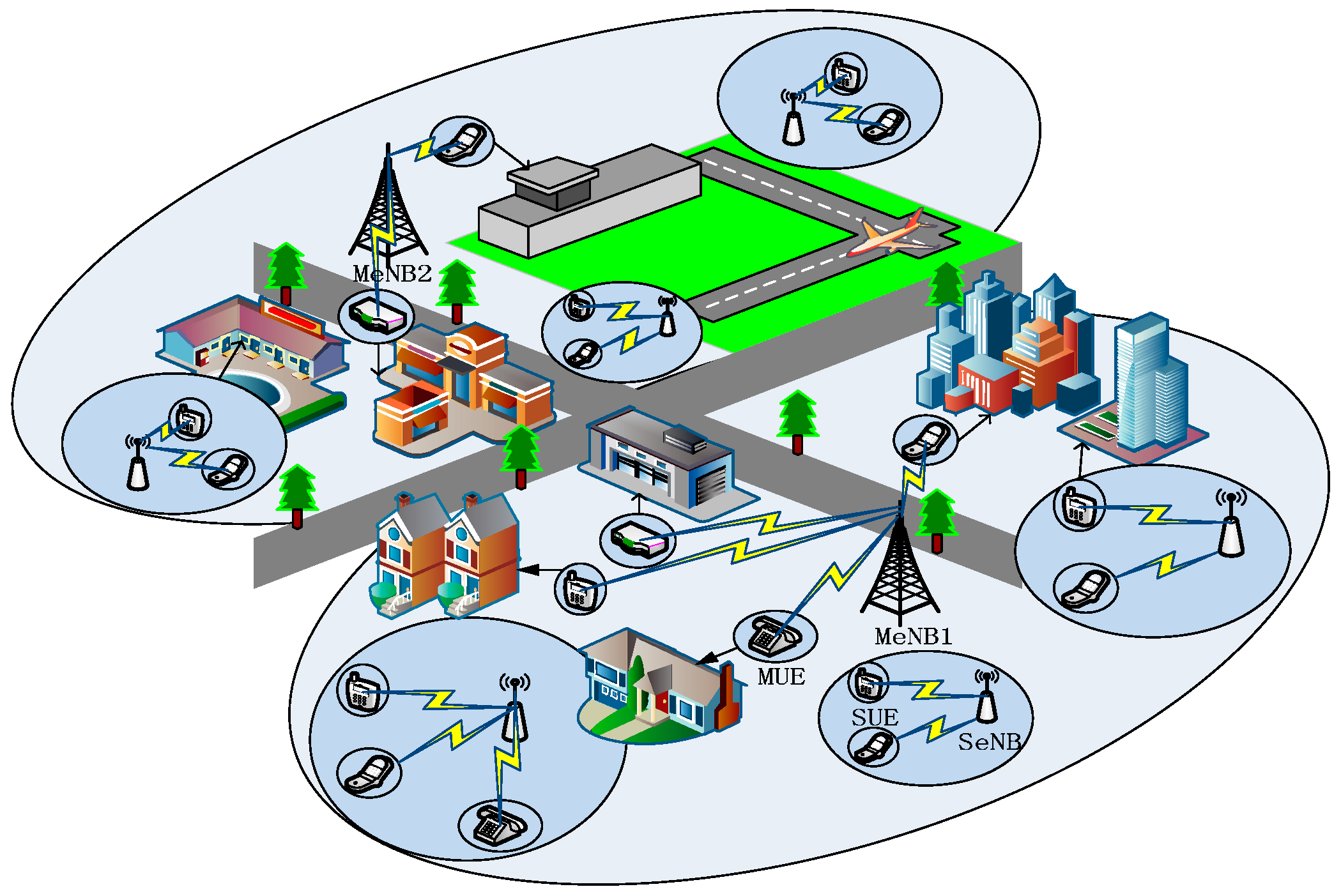

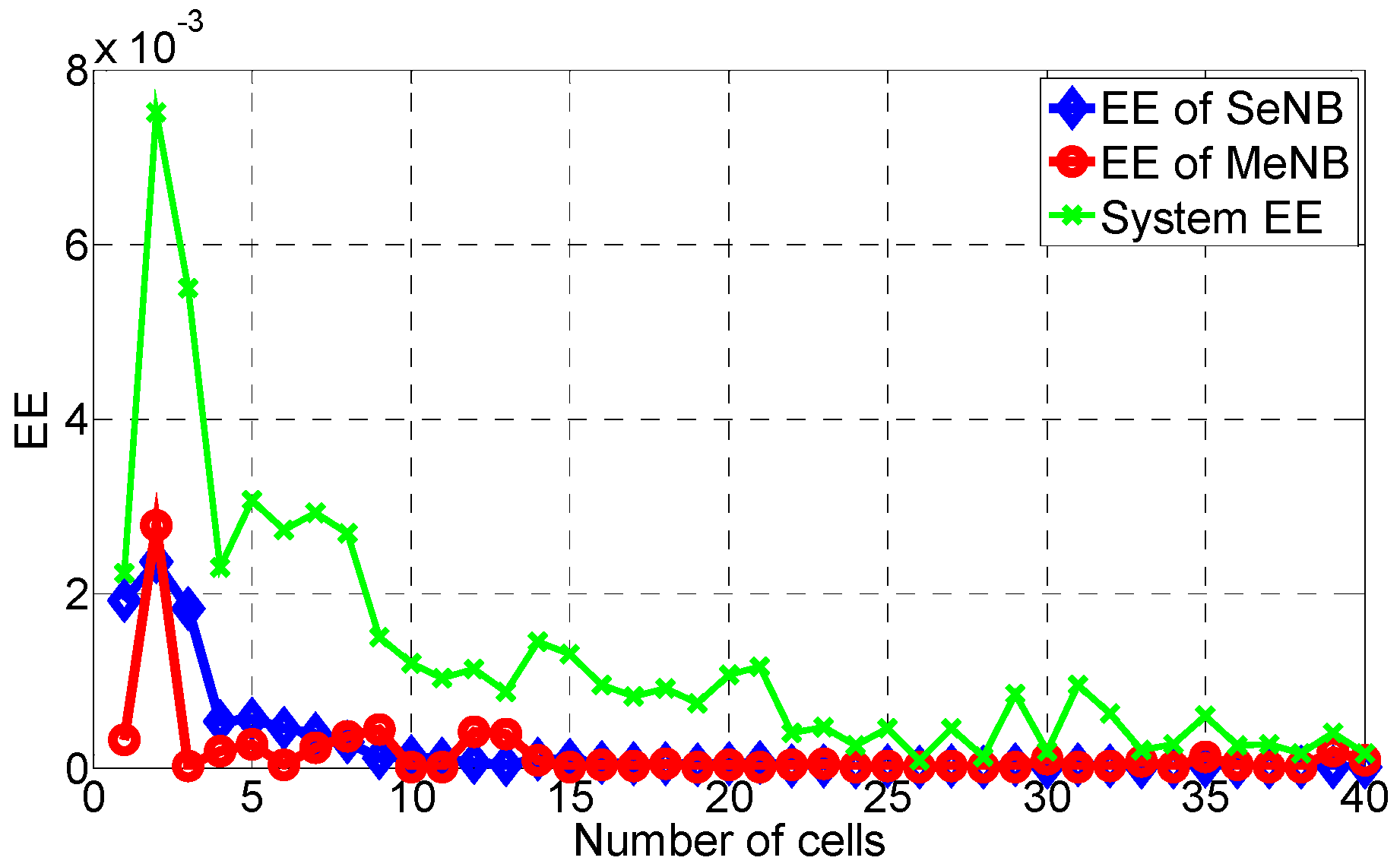

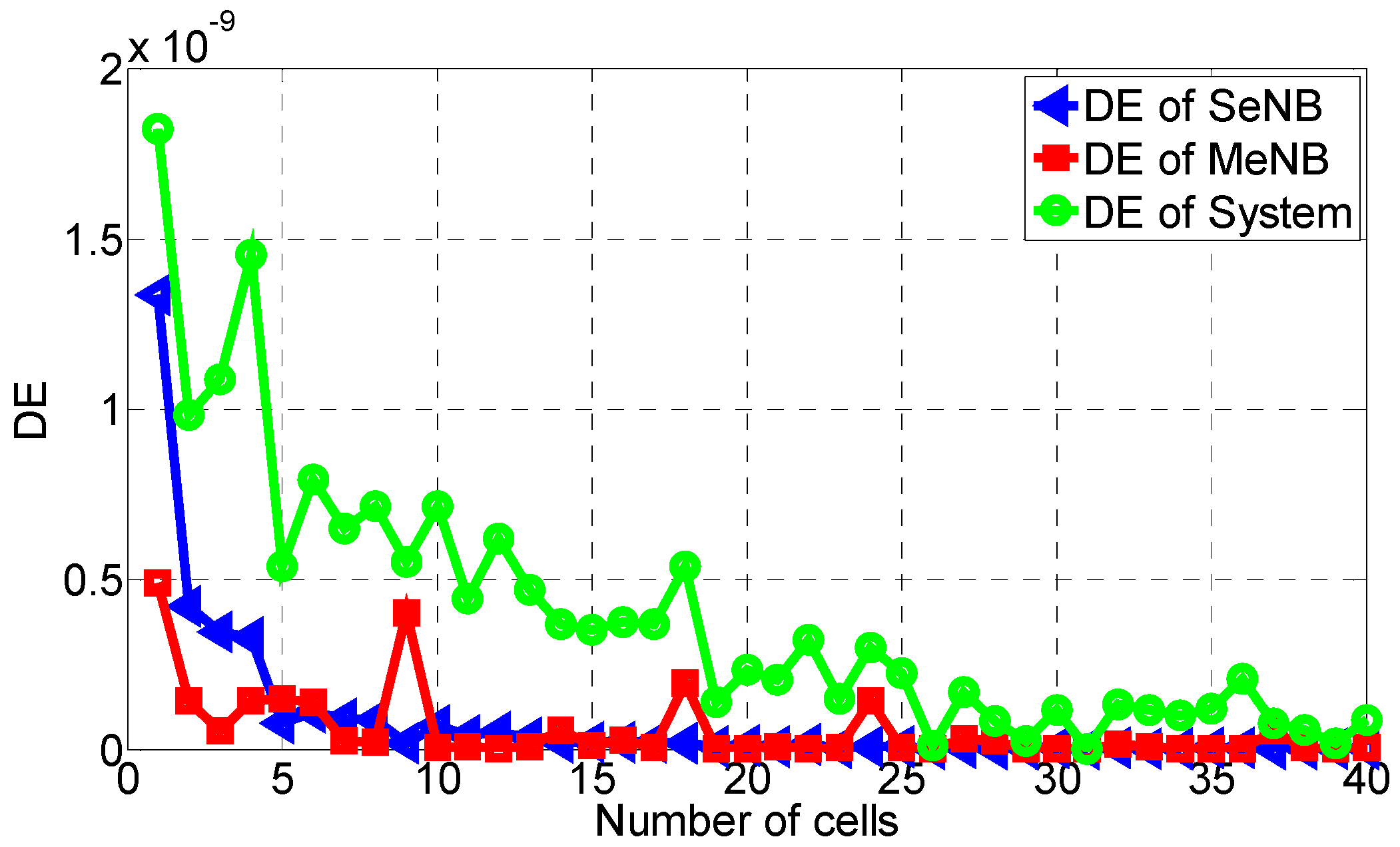
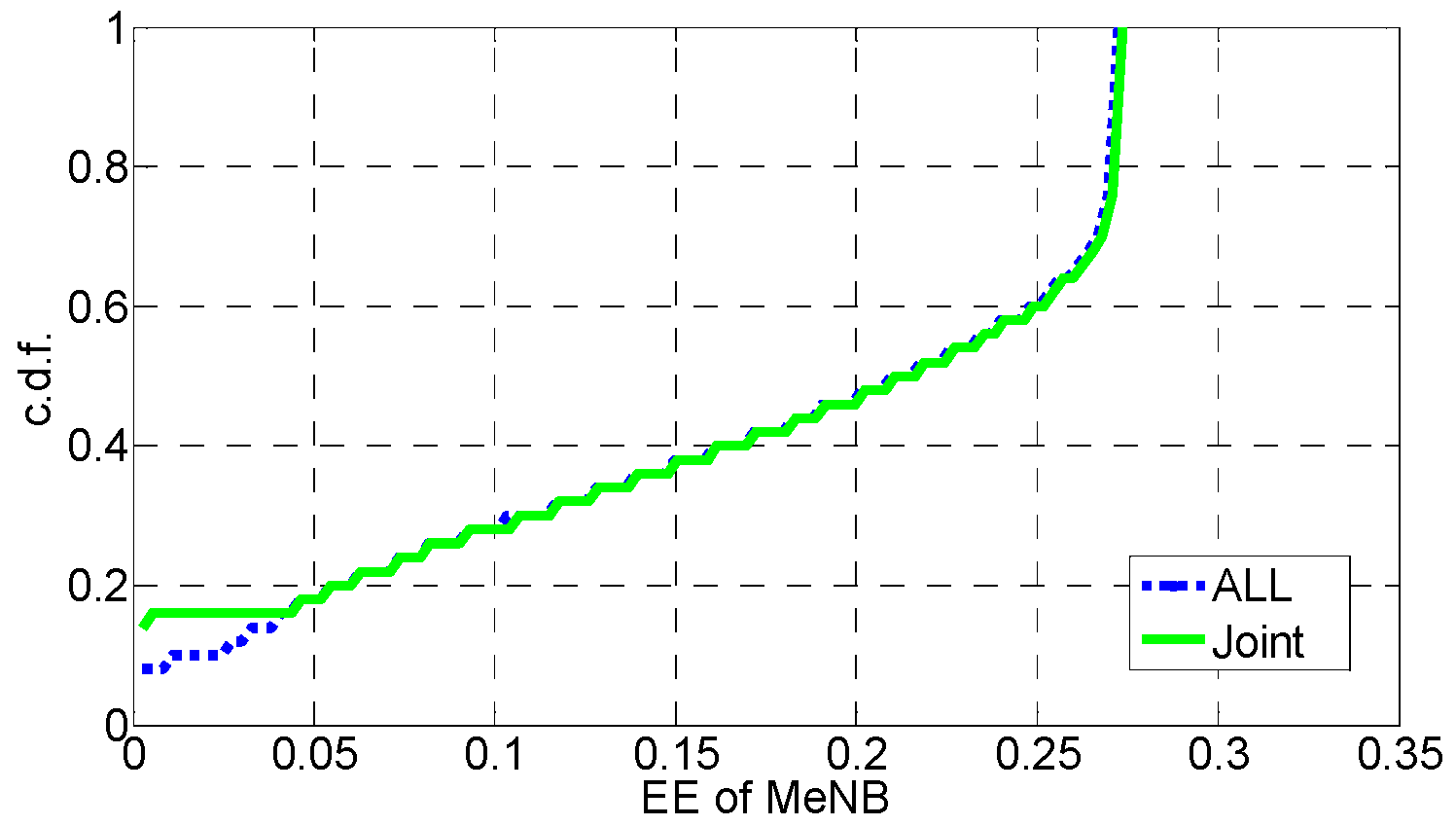
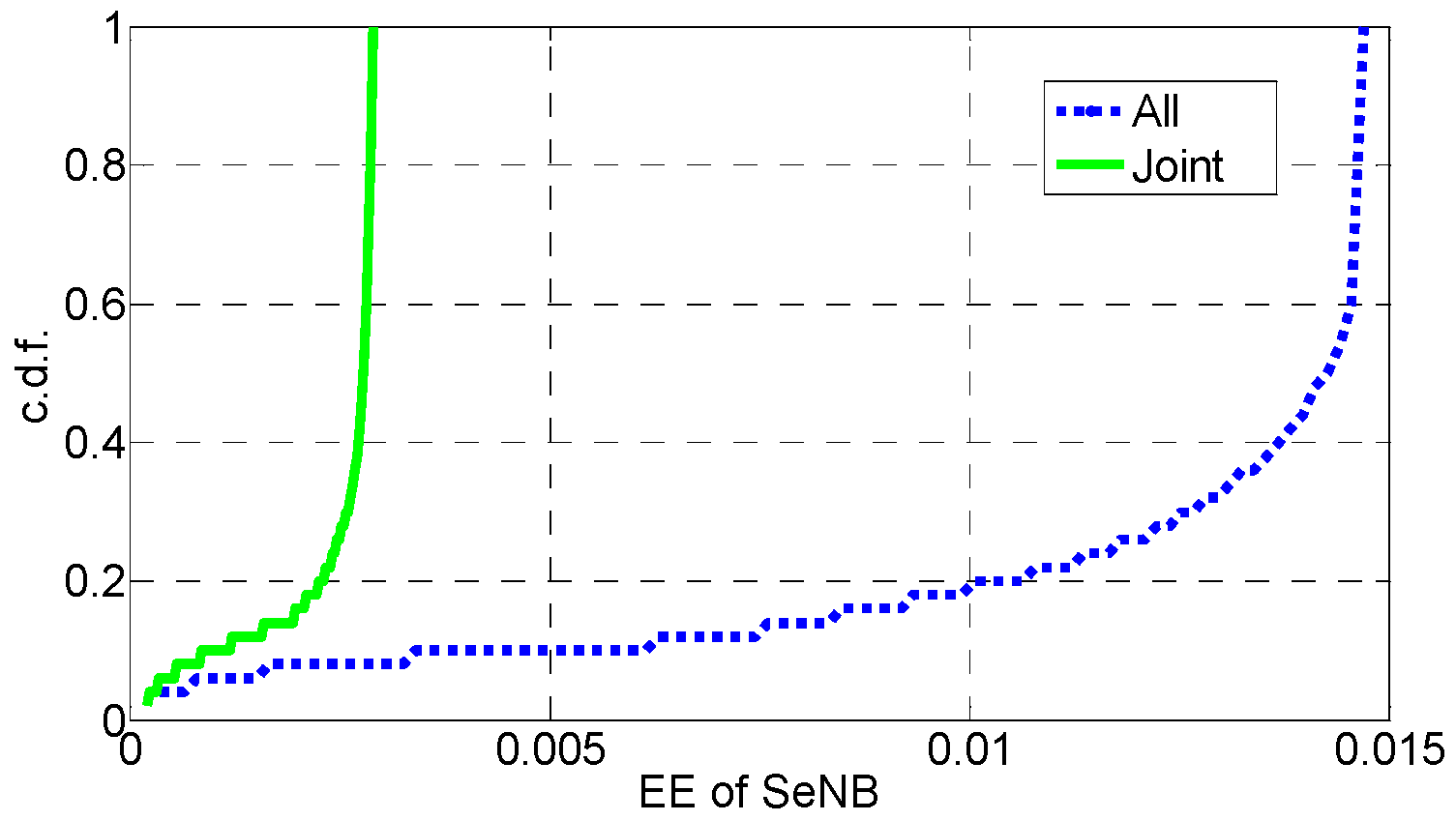
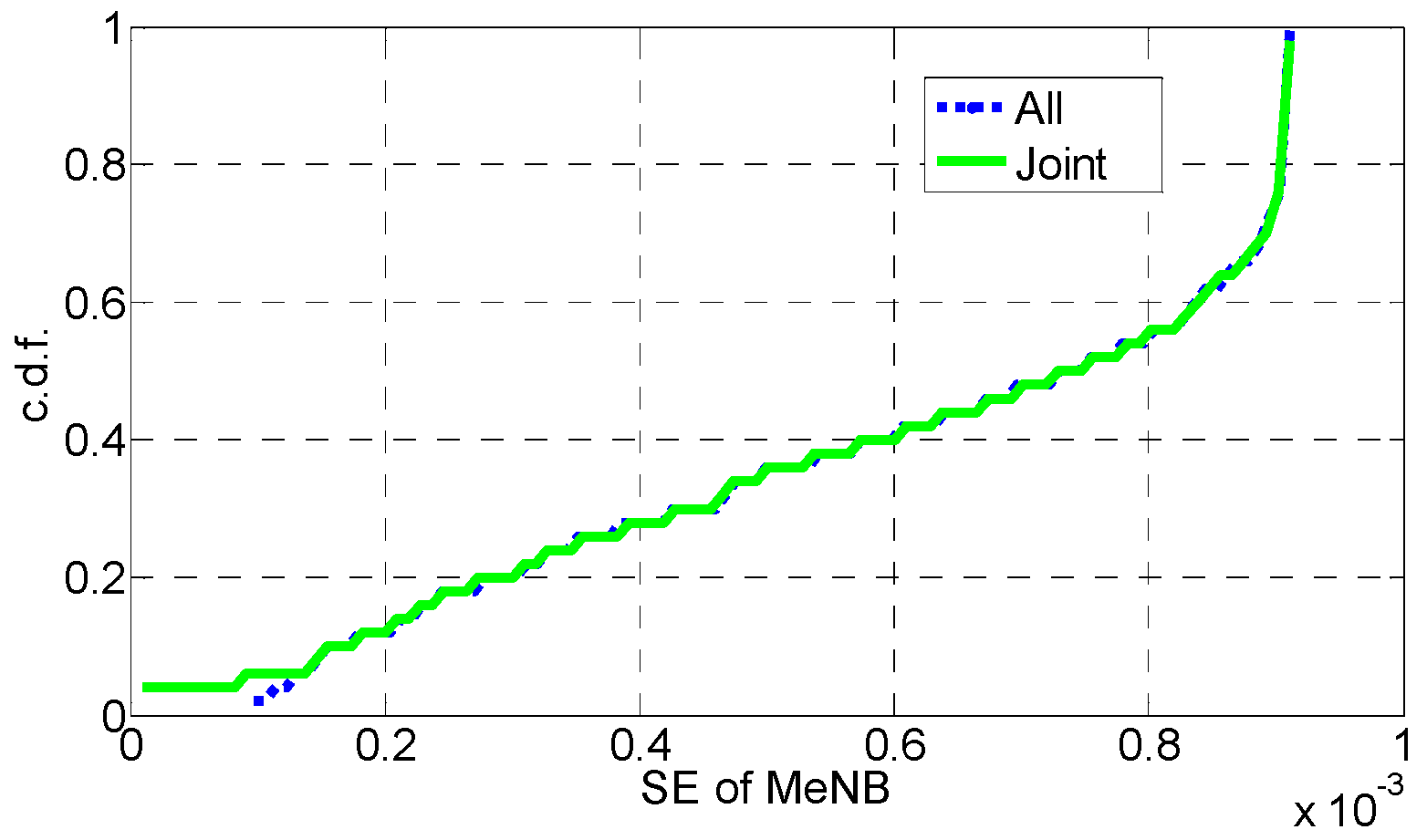

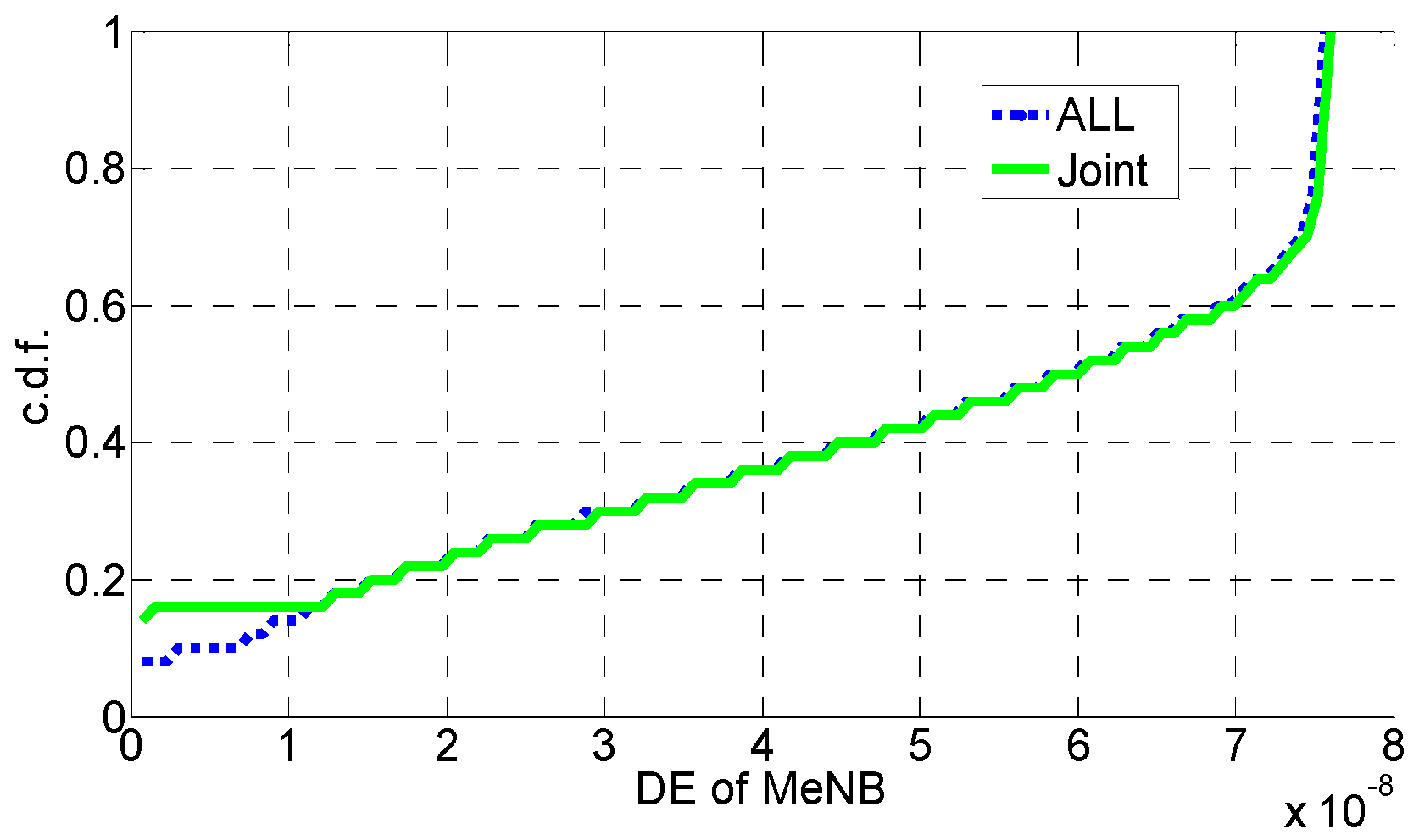
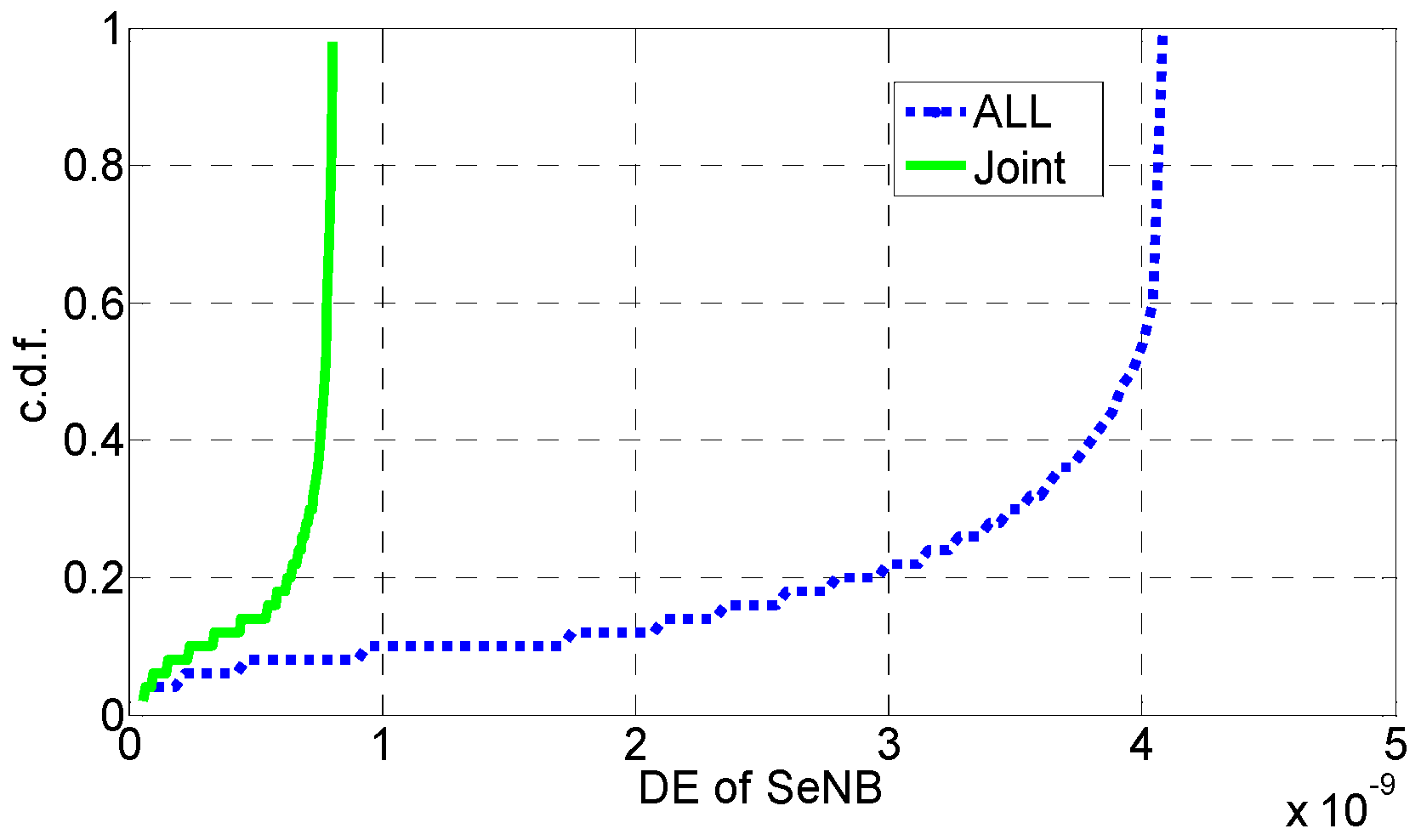
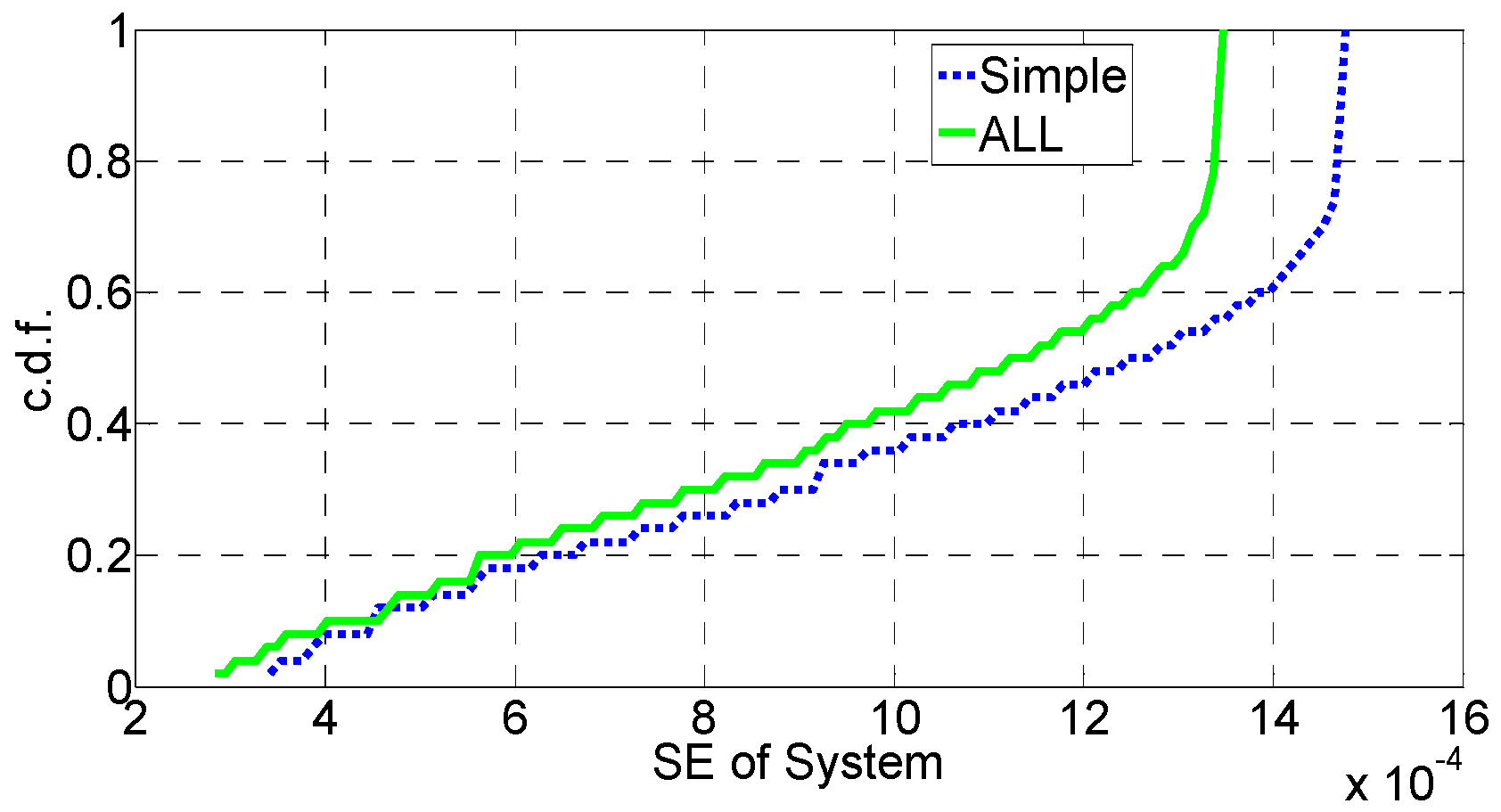

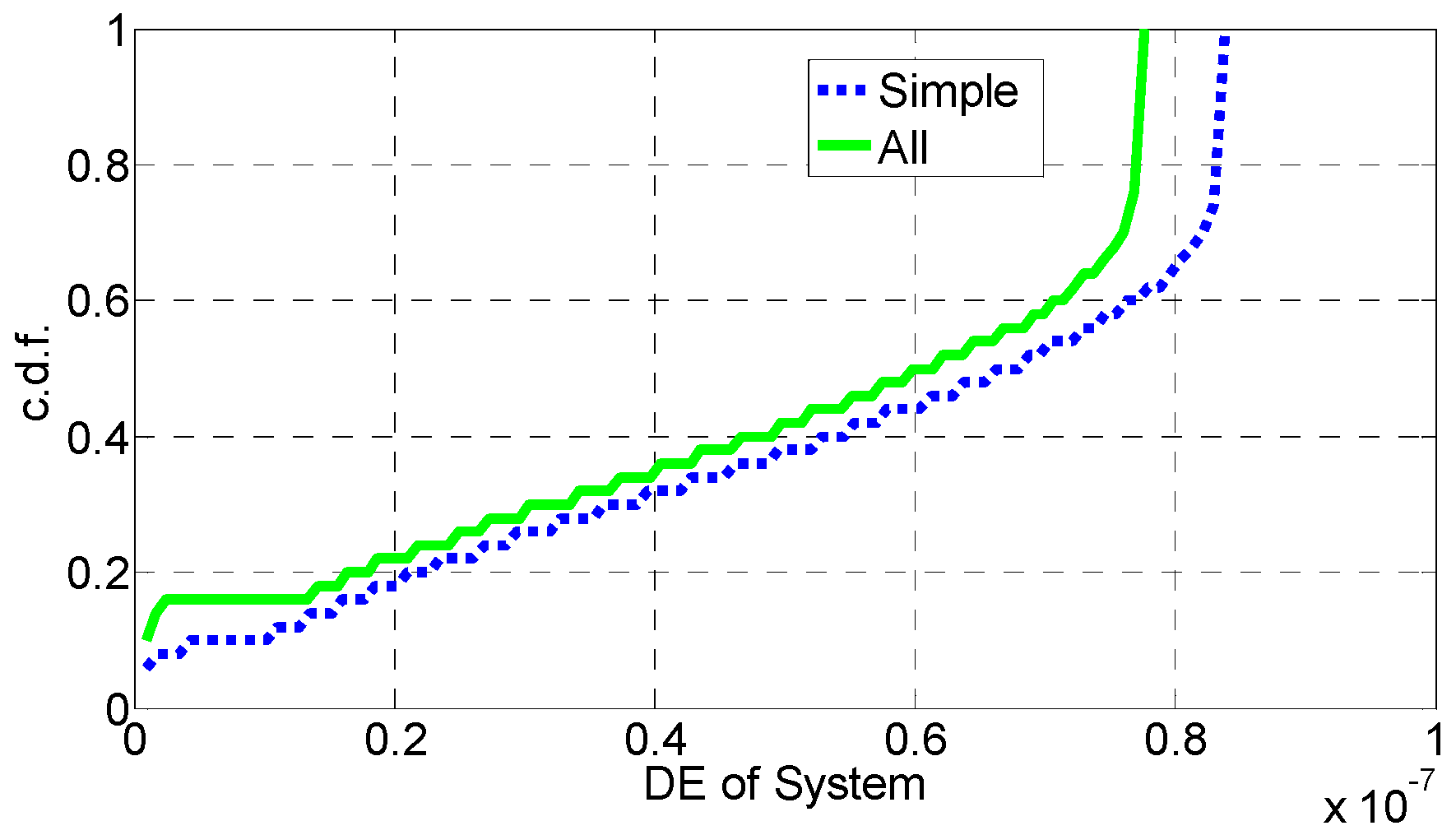
| CapEx () | OpEx () |
|---|---|
| Base-station equipment () | Electric power () |
| Base-station installation and buildout () | Operation and maintenance () |
| Backhaul transmission equipment () | Site lease () |
| Radio network controller equipment () | Backhaul transmission lease () |
| Simulation Parameter | Value |
|---|---|
| Deployment scenario | 5 × 5 grid model |
| Carrier frequency | 2 GHz |
| Bandwidth | 10 MHz |
| Coverage radius of the MBS | 500 m |
| Shadowing standard deviation*2 | 10 dB for link between SeNB and SUE 8 dB for other links |
| Minimum distance between SeNB and eNB | 75 m |
| Minimum distance between UE and eNB | 35 m |
| Minimum distance between UE and SeNB | 3 m |
| Minimum distance among SeNBs | 40-m cluster radius |
© 2016 by the authors; licensee MDPI, Basel, Switzerland. This article is an open access article distributed under the terms and conditions of the Creative Commons Attribution (CC-BY) license (http://creativecommons.org/licenses/by/4.0/).
Share and Cite
Li, M.; Chen, P.; Gao, S. Cooperative Game-Based Energy Efficiency Management over Ultra-Dense Wireless Cellular Networks. Sensors 2016, 16, 1475. https://doi.org/10.3390/s16091475
Li M, Chen P, Gao S. Cooperative Game-Based Energy Efficiency Management over Ultra-Dense Wireless Cellular Networks. Sensors. 2016; 16(9):1475. https://doi.org/10.3390/s16091475
Chicago/Turabian StyleLi, Ming, Pengpeng Chen, and Shouwan Gao. 2016. "Cooperative Game-Based Energy Efficiency Management over Ultra-Dense Wireless Cellular Networks" Sensors 16, no. 9: 1475. https://doi.org/10.3390/s16091475
APA StyleLi, M., Chen, P., & Gao, S. (2016). Cooperative Game-Based Energy Efficiency Management over Ultra-Dense Wireless Cellular Networks. Sensors, 16(9), 1475. https://doi.org/10.3390/s16091475






